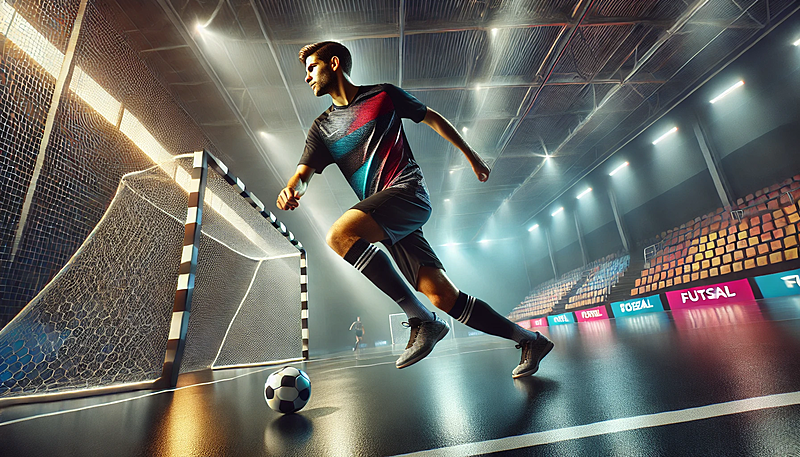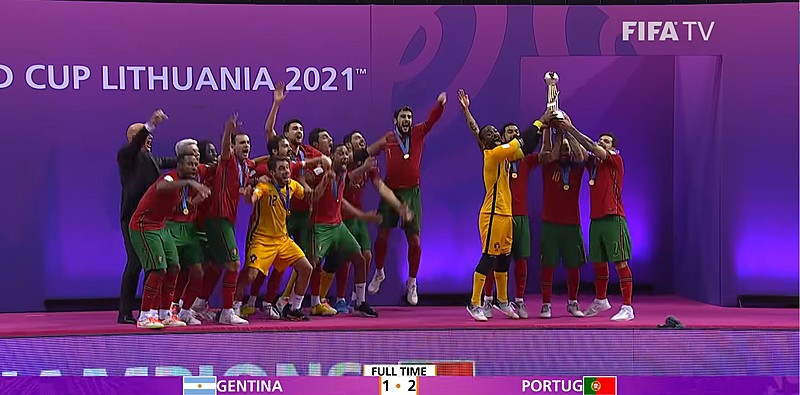Tomorrow in Barcelona, best four teams of the European continent will face off in the UEFA Futsal Champions League finals. Semi-finals will be played on 9th October, while match for third place and final match will be played on Sunday 11th October. We will be reporting about these matches as they happen right here on FutsalFeed.com.
In our recent article on UEFA Futsal Champions League rebranding, you could have read a short history note about the early beginnings of this competition, called back then the European Futsal Club Championship. In this article however, we will offer a historical overview of this competition since UEFA stepped in to take ‘patronage’ over it and its rebranding in 2018. Basically, we will take a closer look at the competition that took place from season 2001/2002 and which was known as UEFA Futsal Cup.
Early Futsal Challenges (2001-2006)
In the first five editions of the UEFA Futsal Cup, the competition was still ‘trying to find itself’. The number of team participating varied, but in general, a Qualifying round consisting of 8 groups existed. Best team from each group qualified to the second qualifying round which was made of two groups of four teams. Only the best team from each group qualified for the final match, except for first and fifth edition of the UEFA Futsal Cup when semi-final matches were featured as well.
As we said earlier, the competition was still searching for best road to take, but that did not stop the best teams to showcase their talent. Spanish side Playas de Castellón won first two editions against Belgium’s Action 21 Charleroi with their first match-up being a one-legged event (2001-02 & 2002-03). Rest of the final matches were played as two-legged events, a classic home and away match arrangement with goal aggregate system. Third edition was won by another Spanish side, Inter (Movistar) FS, who would later become the most successful team of the competition (five titles) and who won their first title against Portuguese powerhouse Benfica (2003-04).
Action 21 Charleroi finally won the competition in their third attempt in the finals (2004-05). Their ‘victims’ were Dinamo Moscow who ‘fell’ after an incredible two-legged thriller. First match was won 4-3 by Action 21 in Belgium, but when the teams went to play in Moscow we could have witnessed a true futsal classic. After 40 minutes of play, scoreboard showed a 4-3 advantage for Dinamo Moscow, thanks to a late goal by the Russians, which meant extra-time drama. In 45th minute, Dinamo had a lead advantage, but in matter of seconds in the 48th minute, Action 21 Charleroi scored two goals, tied the game to 6-6, and won 10-9 on aggregate. To this date, the final match in Moscow remains the final with most goals in the UEFA Futsal Cup/Futsal Champions League.
Interestingly, Dinamo Moscow played in the finals again the following year (2005-06), but came short yet again as Inter FS were better in their two-legged duel. It was also the last two-legged final of this competition. Furthermore, Dinamo Moscow won the European title once (2006-07), but lost in the finals another five times, which makes them the ‘unluckiest’ team in history of UEFA Futsal Cup finals. Or the best runner-up, depends on your perspective.
Final Four Format (2006-2017)
From season 2006-07 and onwards, UEFA Futsal Cup featured a Final Four tournament. Getting there, however, was anything but easy. Competition was divided in four stages. First one was the Preliminary round whose number of participating teams and groups varied throughout the years, but general rule of thumb was that only the best team from each group would qualify for the Main round.
Winners from the Preliminary round, together with teams that received bye from Preliminary round due to their club coefficient, made the Main round of the UEFA Futsal Cup which consisted of six groups of four teams. Matches in each group were played out in a host city, one for each group. Best two teams from each group would progress to the next stage, called Elite round, where they would be joined by best four European teams (on basis of their club coefficient).
The Elite round of the UEFA Futsal Cup was made of four groups of four teams and only the best team from each group would progress to the Final Four tournament that took place in a designated city and venue. Remaining teams were drawn in two semi-final match-ups and the winners of those match-ups played in the final for the title.
As it was mentioned earlier in the article, Dinamo Moscow were the first winners of this ‘new’ Final Four format, when they fittingly won against Action 21 in the semis and defeated Inter FS in the final. A fitting ‘revenge’ for loosing from those two teams in the last two finals. Next year, another Russian team won the UEFA Futsal Cup. Sinara Yekaterinburg was successful against this year’s finalist ElPozo Murcia (their first, and so far, only final) in another thriller after penalties (2007-08).
Inter FS were quick to break the spell of Russian dominance as next year they quite convincingly won against the champion at the time, Sinara Yekateringurg, 5-1 (2008-09). Inter were in the finals yet again next year, but this time they were stopped by Benfica, who won 3-2 after extra time. It was the first Portuguese title of this competition (2009-10). Their Lisbon rivals, Sporting CP, had a chance of clinching the title themselves the following season, but Italian side Montesilvano cruised to the convincing 5-2 victory. Montesilvano are still the only Italian team to clinch this European competition (2010-11).
Next three editions of the UEFA Futsal Cup saw one same team in the finals that never made that last step. Yeah, you guessed it – the beforementioned Dinamo Moscow failed to clinch the title three times in a row. Firstly, they were stopped by Barcelona who played their first UEFA Futsal Cup final and won 3-1 (2011-12). Next year, Kairat Almaty, a new powerhouse that have been regarded as one of the top teams since then, won 4-3 in a very close final in Tbilisi (2012-13). Following year, Dinamo Moscow faced Barcelona again in a final match in Baku. Once again, Spanish side was victorious, although their success came only after extra time (2013-14). Match ended 5-2, but Dinamo Moscow were trailing only one goal up until the last seconds of the match.
Following year, Barcelona made it to final match once again. They squared off with Kairat Almaty who were more concentrated side in the match in Lisbon which ended 3-2 for Kairat (2014-15). Next season, Russian team Gazprom-Ugra Yugorsk returned the European title to Russia. In final minutes of an exciting match, Gazprom-Ugra managed to secure a 4-3 win over Inter FS (2015-16). However, after 8 years, Inter FS managed to lift the trophy once again, for the fourth time. In Almaty Arena, Spanish side recorded the most dominant win in the history of the UEFA Futsal Cup finals. In a very one-sided match, Inter FS cruised to a 7-0 triumph over Portugal’s Sporting CP (2016-17).
UEFA Futsal Champions League
A new set of changes were due for UEFA Futsal Cup. In April of 2017, UEFA’s Executive Board meeting was held in Helsinki and it envisaged a number of changes to the competition and its format. In yesterday’s article, we went into length describing the changes and we invite you to read it. For our today’s story, the most important thing that we have to notice is that three strongest European nations will have two representatives in the strongest club competition and that from 2018-19 season, the UEFA Futsal Cup will rebrand itself as the UEFA Futsal Champions League.
Format of the Main round also changed. From 2017-18 season, no teams were allowed a bye for the Main round, meaning that all the best teams on the continent played their European campaign from the Main round and not the Elite round like before. Furthermore, the Main round was split into two separate paths: Path A (16 teams, ranked from 1st to 11th and 16th to 19th in the UEFA Futsal Cup club coefficient rankings, drawn into four groups) and Path B (16 teams, ranked 12th to 15th and 20th downwards, also drawn into four groups). The top three teams from the Path A groups and the top team from each of the Path B groups progressed to the Elite round where things remained the same as before.
The new format did not bring any special upsets to the top teams, who actually had a repeat of the last final. Inter FS once again met Sporting CP in a final match held in Zaragoza. Scoreboard was a bit easier on the Portuguese side this time, but in reality, it was once again a one-sided match that Inter FS won 5-2 (2017-18). After meeting in two consecutive finals, these two teams faced off in next-year’s semi-final of the competition that rebranded itself as UEFA Futsal Champions League. This time, it was Sporting who came out victorious and secured their spot in the final against Kairat (who won against Barcelona). We did not see any goals in the first half of the final, but Sporting managed to break away with two goals at the start of the second half. Kairat managed to score once, but it was not enough. In their fourth attempt, Sporting CP finally made it to the title (2018-19).
This brings us to this year’s Final Four event in Barcelona (2019-20). Due to the Covid-19 pandemic, Final Four was pushed back for months, but finally it is happening. Two Spanish teams will face-off with two Russian teams. Barcelona and ElPozo are familiar with this level of competition, but Tyumen and KPRF are in this stage for the first time. ElPozo will play against Tyumen on Friday October 9th at 16:00 local time, while Barcelona will take on KPRF on same day at 21:00 local time. Third place match is on schedule on Sunday, 11th October 16:00 local time, while grand final will be played on the same day at 20:00 local time.
We will keep you posted on these matches as they develop right here at FutsalFeed.com!






